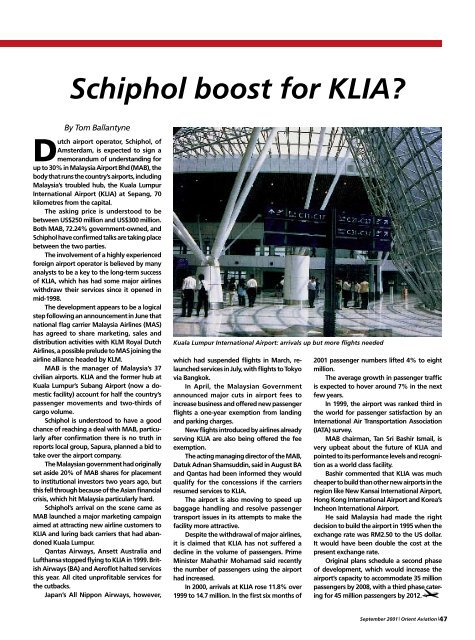You also want an ePaper? Increase the reach of your titles
YUMPU automatically turns print PDFs into web optimized ePapers that Google loves.
Schiphol boost for KLIA?By Tom BallantyneDutch airport operator, Schiphol, ofAmsterdam, is expected to sign amemorandum of understanding forup to 30% in Malaysia Airport Bhd (MAB), thebody that runs the country’s airports, includingMalaysia’s troubled hub, the Kuala LumpurInternational Airport (KLIA) at Sepang, 70kilometres from the capital.The asking price is understood to bebetween US$250 million and US$300 million.Both MAB, 72.24% government-owned, andSchiphol have confirmed talks are taking placebetween the two parties.The involvement of a highly experiencedforeign airport operator is believed by manyanalysts to be a key to the long-term successof KLIA, which has had some major airlineswithdraw their services since it opened inmid-1998.The development appears to be a logicalstep following an announcement in June thatnational flag carrier Malaysia Airlines (MAS)has agreed to share marketing, sales anddistribution activities with KLM Royal DutchAirlines, a possible prelude to MAS joining theairline alliance headed by KLM.MAB is the manager of Malaysia’s 37civilian airports. KLIA and the former hub atKuala Lumpur’s Subang Airport (now a domesticfacility) account for half the country’spassenger movements and two-thirds ofcargo volume.Schiphol is understood to have a goodchance of reaching a deal with MAB, particularlyafter confirmation there is no truth inreports local group, Sapura, planned a bid totake over the airport company.The Malaysian government had originallyset aside 20% of MAB shares for placementto institutional investors two years ago, butthis fell through because of the Asian financialcrisis, which hit Malaysia particularly hard.Schiphol’s arrival on the scene came asMAB launched a major marketing campaignaimed at attracting new airline customers toKLIA and luring back carriers that had abandonedKuala Lumpur.Qantas Airways, Ansett Australia andLufthansa stopped flying to KLIA in 1999. BritishAirways (BA) and Aeroflot halted servicesthis year. All cited unprofitable services forthe cutbacks.Japan’s All Nippon Airways, however,Kuala Lumpur International Airport: arrivals up but more flights neededwhich had suspended flights in March, relaunchedservices in July, with flights to Tokyovia Bangkok.In April, the Malaysian Governmentannounced major cuts in airport fees toincrease business and offered new passengerflights a one-year exemption from landingand parking charges.New flights introduced by airlines alreadyserving KLIA are also being offered the feeexemption.The acting managing director of the MAB,Datuk Adnan Shamsuddin, said in August BAand Qantas had been informed they wouldqualify for the concessions if the carriersresumed services to KLIA.The airport is also moving to speed upbaggage handling and resolve passengertransport issues in its attempts to make thefacility more attractive.Despite the withdrawal of major airlines,it is claimed that KLIA has not suffered adecline in the volume of passengers. PrimeMinister Mahathir Mohamad said recentlythe number of passengers using the airporthad increased.In 2000, arrivals at KLIA rose 11.8% over1999 to 14.7 million. In the first six months of2001 passenger numbers lifted 4% to eightmillion.The average growth in passenger trafficis expected to hover around 7% in the nextfew years.In 1999, the airport was ranked third inthe world for passenger satisfaction by anInternational Air Transportation Association(IATA) survey.MAB chairman, Tan Sri Bashir Ismail, isvery upbeat about the future of KLIA andpointed to its performance levels and recognitionas a world class facility.Bashir commented that KLIA was muchcheaper to build than other new airports in theregion like New Kansai International Airport,Hong Kong International Airport and Korea’sIncheon International Airport.He said Malaysia had made the rightdecision to build the airport in 1995 when theexchange rate was RM2.50 to the US dollar.It would have been double the cost at thepresent exchange rate.Original plans schedule a second phaseof development, which would increase theairport’s capacity to accommodate 35 millionpassengers by 2008, with a third phase cateringfor 45 million passengers by 2012.September 2001 | <strong>Orient</strong> <strong>Aviation</strong> | 47







![OAMag-V7N4-Cover [Converted] - Orient Aviation](https://img.yumpu.com/48598575/1/190x255/oamag-v7n4-cover-converted-orient-aviation.jpg?quality=85)








